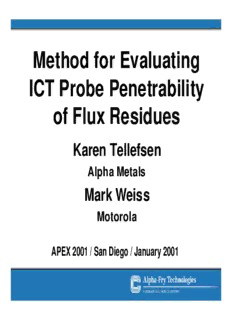
TP-Method of Eval ICT Probe Penetrability of Flux Residues (Apex 06) PDF
Preview TP-Method of Eval ICT Probe Penetrability of Flux Residues (Apex 06)
Method for Evaluating ICT Probe Penetrability of Flux Residues Karen Tellefsen Alpha Metals Mark Weiss Motorola APEX 2001 / San Diego / January 2001 Introduction • Printed wiring boards are getting smaller and increasingly densely populated. • ICT probing is sometimes done on soldered joints covered with solder paste flux residue. – Tough or hard residue may prevent pin from making good electrical contact with the soldered joint • Solder pad size and shape and ICT probe tip shape and for also affect pin penetrability • There is a need for a test to evaluate ICT probe penetrability. Past Work • Mackie, and later Guo et al., measured force-to- contact. – Indication of the relative penetrability of flux residues. – Small number of contacts measured. • Seelig and Suraski measured the contact resistance of several types of ICT probes to a single type of flat SMT pad soldered with different solder pastes. – Saw flux build-up on ICT probes. Current Method • Modified automated dispensing machine – Allows thousands of accurate ICT probes – Different kinds of soldered pads. – Measures resistance – Enhancement of Motorola’s Initial method. • ICT pin probe-ability studied for: – various solder pastes – solder reflow conditions – solder pad shapes – ICT probe tip shape and pin force Description of test method • Modified Camalot 3800 Dispensing System – high-speed, accurate x-y table with a z-axis head with excellent vision system – small metal ICT socket holds a QA type-100 spring- loaded ICT pin probe – programmed to allow the ICT pin to accurately and sequentially hit thousands of soldered pads – z-axis control is set so that the pin is depressed in accordance with the pin specification and exerts the same force for all probe contacts. Description of test method • Motorola measurement circuit – only evaluated circuit continuity – indicates continuity by activating a 5V relay • Contact resistance measurement circuit – Simple voltage divider – measures voltage drop across contact resistance – data acquisition system (National Instruments PC-516 DAQ card programmed with LabView software) – Resistance calculated and stored in ASCII file for import into spreadsheet.
Description: